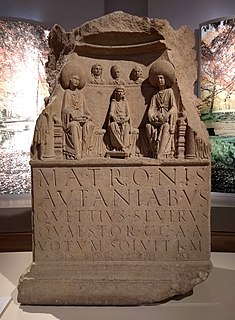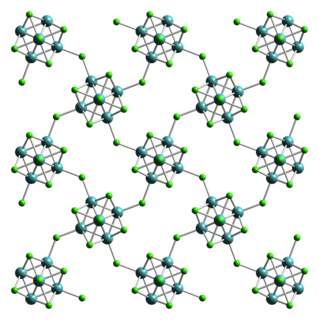Inorganic chemistry deals with the synthesis and behavior of inorganic and organometallic compounds. This field covers all chemical compounds except the myriad organic compounds, which are the subjects of organic chemistry. The distinction between the two disciplines is far from absolute, as there is much overlap in the subdiscipline of organometallic chemistry. It has applications in every aspect of the chemical industry, including catalysis, materials science, pigments, surfactants, coatings, medications, fuels, and agriculture.

Brine is a high-concentration solution of salt in water. In different contexts, brine may refer to salt solutions ranging from about 3.5% up to about 26%. Lower levels of concentration are called by different names: fresh water, brackish water, and saline water.

The Matronae Aufaniae were one name for Celtic mother goddesses (Matronae) worshipped throughout Celtic Europe. They are known only from inscriptions and reliefs, which have been found mainly in the German Rhineland.
In ancient Roman religion, the Furrinalia was an annual festival held on 25 July to celebrate the rites (sacra) of the goddess Furrina. Varro notes that the festival was a public holiday (feriae publicae dies). Both the festival and the goddess had become obscure even to the Romans of the Late Republic; Varro notes that few people in his day even know her name. One of the fifteen flamines was assigned to her, indicating her archaic stature, and she had a sacred grove (lucus) on the Janiculum, which may have been the location of the festival. Furrina was associated with water, and the Furrinalia follows the Lucaria on 19 and 21 July and the Neptunalia on 23 July, a grouping that may reflect a concern for summer drought.

Nickel(II) chloride (or just nickel chloride), is the chemical compound NiCl2. The anhydrous salt is yellow, but the more familiar hydrate NiCl2·6H2O is green. Nickel(II) chloride, in various forms, is the most important source of nickel for chemical synthesis. The nickel chlorides are deliquescent, absorbing moisture from the air to form a solution. Nickel salts have been shown to be carcinogenic to the lungs and nasal passages in cases of long-term inhalation exposure.

Ion chromatography is a chromatography process that separates ions and polar molecules based on their affinity to the ion exchanger. It works on almost any kind of charged molecule—including large proteins, small nucleotides, and amino acids. However, ion chromatography must be done in conditions that are one unit away from the isoelectric point of a protein.
Common Logic (CL) is a framework for a family of logic languages, based on first-order logic, intended to facilitate the exchange and transmission of knowledge in computer-based systems.

The Canadair CL-84 "Dynavert", designated by the Canadian Forces as the CX-131, was a V/STOL turbine tiltwing monoplane designed and manufactured by Canadair between 1964 and 1972. Only four of these experimental aircraft were built with three entering flight testing. Two of the CL-84s crashed due to mechanical failures, with no fatalities occurred in either of the accidents. Despite the fact that the CL-84 was successful in the experimental and operational trials carried out between 1972 and 1974 however, none of the prospective customers placed any orders for the type.
A salt metathesis reaction, sometimes called a double replacement reaction, double displacement reaction, or double decomposition reaction, is a chemical process involving the exchange of bonds between two non-reacting chemical species which results in the creation of products with similar or identical bonding affiliations. This reaction is represented by the general scheme:
Titanium(III) chloride is the inorganic compound with the formula TiCl3. At least four distinct species have this formula; additionally hydrated derivatives are known. TiCl3 is one of the most common halides of titanium and is an important catalyst for the manufacture of polyolefins.

Molybdenum dichloride describes chemical compounds with the empirical formula MoCl2. At least two forms are known, and both have attracted much attention from academic researchers because of the unexpected structures seen for these compounds and the fact that they give rise to hundreds of derivatives. The form discussed here is Mo6Cl12. The other molybdenum(II) chloride is potassium octachlorodimolybdate.
Chromatographic techniques have been used in blood processing and purification since the 1980s. It has emerged as an effective method of purifying blood components for therapeutic use.

Protein C inhibitor is a serine protease inhibitor (serpin) which limits the activity of protein C.

Diethylaminoethyl cellulose (DEAE-C) is a positively charged resin used in ion-exchange chromatography, a type of column chromatography, for the separation and purification of proteins and nucleic acids. Gel matrix beads are derivatized with diethylaminoethanol (DEAE) and lock negatively charged proteins or nucleic acids into the matrix. The proteins are released from the resin by increasing the salt concentration of the solvent or changing the pH of the solution as to change the charge on the protein.

The Hellenic Air Force Museum was founded in 1986 and since 1992 has been located on Dekelia Air Base in Acharnes north of Athens. In opposition to the War Museum of Athens it displays air force history and is active in restoring and presenting old aircraft. Most aircraft in the collection come from the Hellenic Air Force; some were exchanged with other European aircraft museums.

Chloride channel 7 alpha subunit also known as H+/Cl− exchange transporter 7 is a protein that in humans is encoded by the CLCN7 gene. In melanocytic cells this gene is regulated by the Microphthalmia-associated transcription factor.

Anion exchange protein 3 is a membrane transport protein that in humans is encoded by the SLC4A3 gene. AE3 is functionally similar to the Band 3 Cl−/HCO3− exchange protein but it is expressed primarily in brain neurons and in the heart. Like AE2 its activity is sensitive to pH. AE3 mutations have been linked to seizures.

Diethylethanolamine (DEAE) is a chemical compound with the molecular formula C6H15NO. It is used as a precursor in the production of a variety of chemical commodities such as the local anesthetic procaine. It can be reacted with 4-aminobenzoic acid to make procaine. DEAE can be used as a precursor for DEAE-cellulose resin, which is commonly used in ion exchange chromatography. DEAE can also be conveniently obtained from renewable sources. It is chemically stable and able to absorb carbon dioxide (CO2) from its surroundings. In solution, it can decrease the surface tension of water when the temperature is increased.
Anion-exchange chromatography is a process that separates substances based on their charges using an ion-exchange resin containing positively charged groups, such as diethyl-aminoethyl groups (DEAE). In solution, the resin is coated with positively charged counter-ions (cations). Anion exchange resins will bind to negatively charged molecules, displacing the counter-ion. Anion exchange chromatography is commonly used to purify proteins, amino acids, sugars/carbohydrates and other acidic substances with a negative charge at higher pH levels. The tightness of the binding between the substance and the resin is based on the strength of the negative charge of the substance.
Harrison Paul Davis III is a former American football wide receiver in the National Football League who played for the San Diego Chargers. He played college football for the Virginia Cavaliers.













